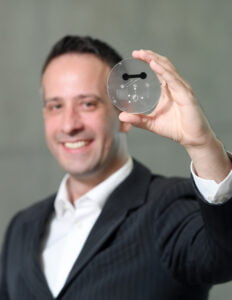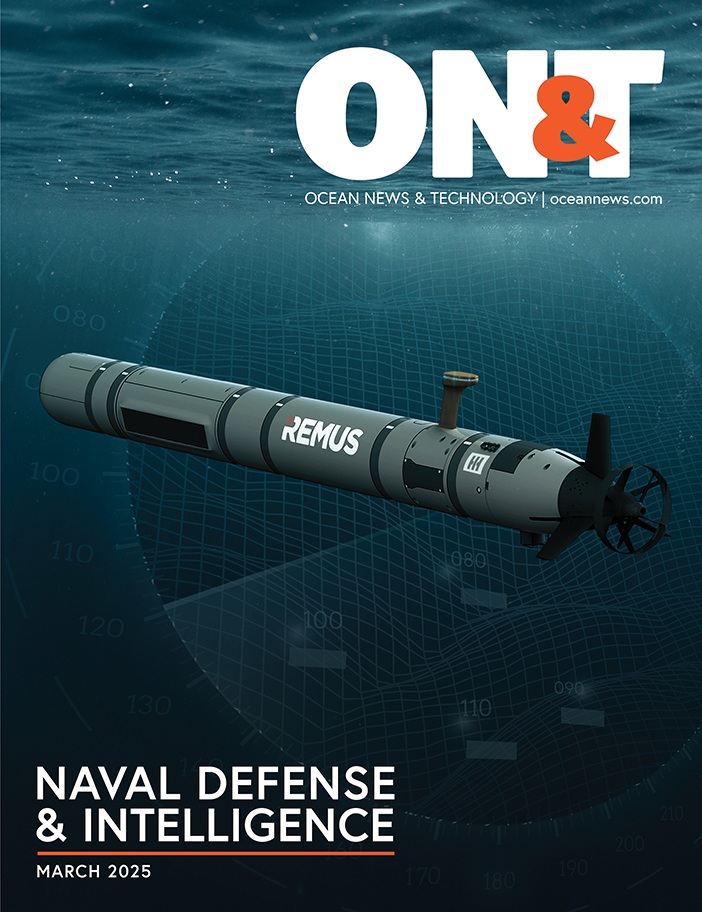Sieben has spent the better part of fifteen years developing this technology, and since March of 2018, he has worked with Dal’s Ocean’s Engineering Hub to utilize the technology in developing tiny in-situ microfluidic sensors to monitor nutrients, metals, hydrocarbons and microbes in the ocean.
In collaboration with other researchers, including Dr. Mae Seto who was recently appointed the Irving Shipbuilding Chair in Marine Engineering and Autonomous Systems, and Dr. Douglas Wallace from Dal’s Department of Oceanography, Sieben plans to integrate his sensors onto underwater vehicles. The miniature chips are housed on a portable power system and then strapped onto Autonomous Underwater Vehicles (AUV) and deployed into the ocean. The sensors are intended to collect data within environments often too dangerous or too expensive for human exploration. From there, the chips allow researchers to instantly measure valuable characteristics of the ocean’s chemistry including nitrate, nitrite, ammonium, phosphate, silicate and iron.
Sieben says one of the main challenges in developing lab-onchip devices for the deep sea is the design and fabrication of the device on a very small scale. These tools must be both cost efficient and functional, and of course, small enough to fit onto a small robot.
“The focus of our lab-on-a-chip program is to develop sensors that are better suited for long-term deployment at sea without having scientists themselves go out to collect the data,” he says. “So if we have miniature sensors that are small enough to integrate onto these AUVs, and that consume very little power, then we can conceivably collect much more ocean data over space and time.”
A SEA OF KNOWLEDGE
Traditionally, advances in lab-on- a-chip technology have focused mainly in the area of healthcare and recently in oil and gas. However, in 2008, a group of scientists at the National Oceanography Center in Southhampton, UK conducted research on the first lab-on-chip nutrient and microbiology sensors for the deep ocean. Their team of researchers included Dr. Vince Sieben. Their chip, powered by a support system roughly the size of a large drinking bottle, was dropped into the ocean at a depth of 1,600 m and used to measure the temperature and salinity of the water.
“The professors who recruited me at the time had a vision of utilizing microfluidics in harsh environments. When it came to this type of technology, the work was a change in complexity that really excited me,” says Sieben. “The thought of throwing a lab-on-a chip system in the deep blue put butterflies in my stomach. So, I joined their group.”

Sieben says lab-on-a-chip i n t e g rates many areas of technology including microfluidics and nanofluidics. The devices incorporate several laboratory functions on a chip that ranges in size from a few millimeters to a few square centimeters. Sample analysis occur on location rather than being transported to a larger laboratory. He says the process, which helps achieve thorough automation, also reduces the risk of human error and interpretation.
“Many of the biogeochemical measurements performed on marine water still rely on wetchemistry protocols. When scientists perform these finelytuned and sensitive processes in a laboratory, there can exist slight variations that yield dramatically different results,” he says. “When we string these processes together on-chip, the sample never leaves our closed channels. It is treated the same as the 1000 other samples before it had been. This leads to unprecedented repeatability across a wide-range of users.”
Following his work in Southampton , Sieben was a senior scientist at Schlumberger, the oil field service provider. He was the lead scientist on the team that delivered MazeTM, the first commercialized microfluidic sensor in the oil and gas industry. The technology coupled novel microfluidic chip technology and spectroscopy for precise measurements, and fully automated well over 400 step process for testing geographically diverse oil samples for saturates, aromatics, resins, and asphaltenes (SARA).
While at Schlumberger, Sieben also developed expertise in AUVs and Robotics for subsea inspection and maintenance.
“What became apparent to me while working there was the fact there’s a lot of infrastructure that humans have deployed throughout the ocean, but it can be quite costly to continuously monitor those structures,” he says. “Ultimately, both the oil and gas industry and oceanographers are looking to reduce the cost of going out and gathering chemical and biological measurements at sea, and lab-on chip technologies are well suited to address these challenges when coupled with autonomous vehicles.”
A NEW WAVE OF OCEANS RESEARCH
In the Spring of 2017, Faculty of Engineering Associate Professor, Dr. Mae Seto, was appointed the Irving Shipbuilding Chair in Marine Engineering and Autonomous Systems. Part of her research focuses on intelligent autonomous systems, and marine robotics, particularly for deployment in difficult environments such as marine and under-ice.
“One of the reasons I like working with Dr. Seto is because she always says that her robots are there for a reason, and that reason is for the sensors,” says Sieben. “Whether you’re looking for nutrient trends like we’re doing here at Dal, or monitoring infrastructure as we were doing at Schlumberger, there’s always some type of question you want answered, and those answers require sensors, and those sensors require robots.”
In 2018, Sieben and his team (Andre Hendricks, Cesar Rodriguez, Sean Morgan, Eddy Luy) created and tested Dal’s first lab-on-chip sensor for the deep ocean. Deployment occurred in the heart of Halifax’s Bedford Basin.
The chip, coined by Sieben as “Generation Zero,” was housed in a selfpowered system that included all of the off the shelf components required in developing a sensor, including tubing and wires. The box however was the size of a carry-on piece of luggage, and substantially too large to strap onto one of Seto’s small underwater vehicles.
In the summer of 2019, Sieben removed all of the original off the shelf components to his model, and engineered a smaller and sleeker sensor that attached onto a Riptide AUV, developed by BAE Systems’ Riptide Autonomous Solutions. Ultimately, he sees the chip becoming much smaller.
“I want to see the evolution of the chip,” said Sieben, “I want to go from the big piece of carryon luggage which we built last year, to the smaller tube we’re creating now. Then I want to create an even smaller sensor hockey puck sized, and finally build something that’s the size of a credit card.”
Sieben says, “What excites me about applying lab-on-achip technologies for ocean monitoring is the cross generational impact that it can have. When I look at my children’s children, I’m hopeful that we will have figured out a way to either measure our impact on the ocean ecosystem or at least be aware on how we’re disturbing them. Our sensors are at the core of that solution.”
For more information, visit www.siebenlab.com.
This story was originally featured in ON&T Magazine’s February 2020 issue. Click here to read more.

